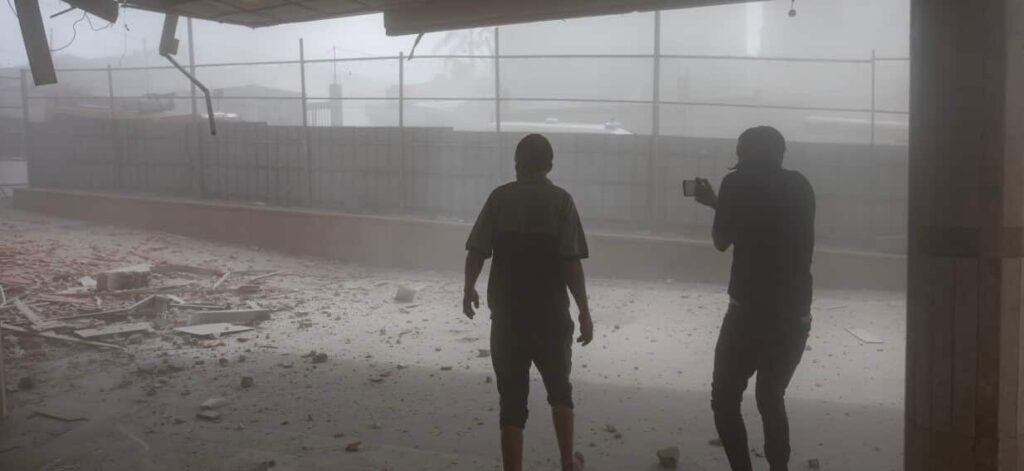
Israel has been accused of conducting a military tactic known as a “double-tap” strike following a bombing this week at the Nasser Hospital, one of Gaza’s largest medical facilities. The initial strike reportedly killed at least one person, but a subsequent explosion minutes later struck the scene as emergency responders, journalists, and medical personnel arrived, resulting in at least 20 fatalities, including five journalists and several healthcare workers.
Israeli Prime Minister Benjamin Netanyahu referred to the incident as a “tragic mishap.” Critics, including human rights organizations and officials from the United Nations, argue that the attack exhibits the characteristics of a double-tap strike, a tactic that some contend could be classified as a war crime. Experts note that legally proving a double-tap attack under international law is complex and may have multiple explanations.
Understanding Double-Tap Strikes and International Law
A double-tap strike involves two attacks on the same target in rapid succession. The first strike aims to incapacitate or kill, while the second targets those who respond to the initial incident, such as rescue workers and civilians. Dr. Eyal Mayroz, a senior lecturer in peace and conflict studies at the University of Sydney, emphasized that such strikes are “very controversial” under international law.
“It’s forbidden, and it’s forbidden for a very good reason — to protect rescue workers and wounded people,” he explained. The Geneva Convention protects rescue efforts, and if a second attack is aimed at harming those providing assistance, it could be deemed a war crime.
The bombing of Nasser Hospital has sparked widespread condemnation from various international bodies, including the European Union. Anouar El Anouni, the EU Spokesman for foreign affairs, declared that the killing of journalists and healthcare workers in the strike was “completely unacceptable.” Similarly, Francesca Albanese, the UN Special Rapporteur on the occupied Palestinian territories, described the bombings as “abominable.” She questioned the rationale behind targeting a hospital, particularly when rescuers and journalists were present.
Responses and Reactions to the Incident
Human rights organization Amnesty International has labeled the incident a double-tap strike, describing it as the latest violation of international law under Netanyahu’s leadership. The attack resulted in the deaths of five journalists, including those affiliated with the Associated Press, Al Jazeera, and Reuters. Under international law, it is illegal to target journalists unless they are directly engaged in military activities. According to the Palestinian Journalists Syndicate, at least 240 journalists have been killed in Gaza since October 7.
Netanyahu expressed deep regret over the incident, asserting that Israel’s conflict is with Hamas, not civilians. “Israel values the work of journalists, medical staff, and all civilians,” he stated, adding that a thorough investigation is underway. Israel’s military claimed that six Hamas members were killed in the strike and insisted that none of the journalists were intended targets. “Our goal is to fight terrorists, not journalists or anyone who is not involved in terrorism,” said Israel’s UN ambassador, Danny Danon.
Dr. Ran Porat from the Australian Centre for Jewish Civilisation at Monash University suggested that the Nasser Hospital attack may not have been a deliberate double-tap strike. He indicated that it could have resulted from a malfunction or failure to follow orders. “It’s a horrible and tragic mistake, but I think it’s not even close to the intentional killing of innocent people,” Porat noted. He highlighted the importance of considering the “methodology” behind Israeli strikes.
The Israeli military has started reviewing the circumstances surrounding the attack, aiming to identify “several gaps” in their inquiry.
Despite the ongoing investigations, Hamas has challenged Israel’s account of the casualties, denying that any of the deceased were militants. Additionally, Israel has described another tactic it employs, known as “roof knocking,” where a small munition is fired at a building as a warning prior to a larger strike. While this practice aims to prompt civilian evacuation, it has faced criticism for its effectiveness and legality.
Dr. Mayroz remarked that while roof knocking is framed as a warning, double-tapping is viewed as a means of obstructing rescuers. He also pointed out the possibility of human error, suggesting that the first strike’s target might not have been neutralized, leading to a second attack without adequate consideration for collateral damage.
Determining the legality of the Nasser Hospital strike would require a formal investigation by a competent court, which is often a slow and rare process. Experts assert that proving intent behind the second attack necessitates thorough evidence, such as intercepted communications or credible whistleblower accounts.
The incident raises significant questions about the protection of civilians and rescue workers during armed conflict, particularly in light of the repeated occurrences of casualties among those attempting to assist the injured. As the humanitarian situation in Gaza continues to deteriorate, the international community is left grappling with the implications of such attacks on human rights and military conduct.







